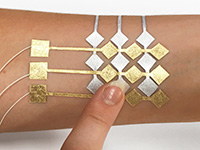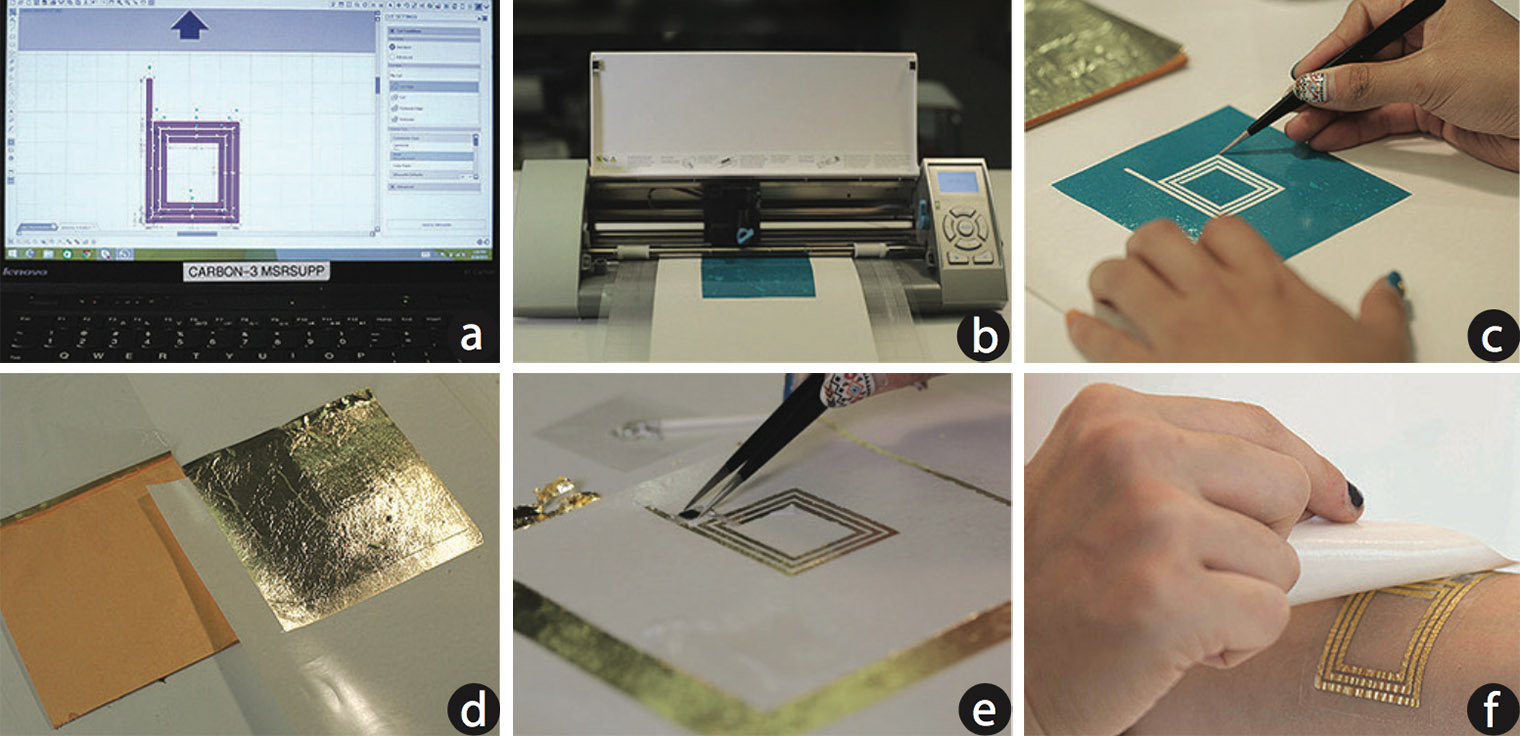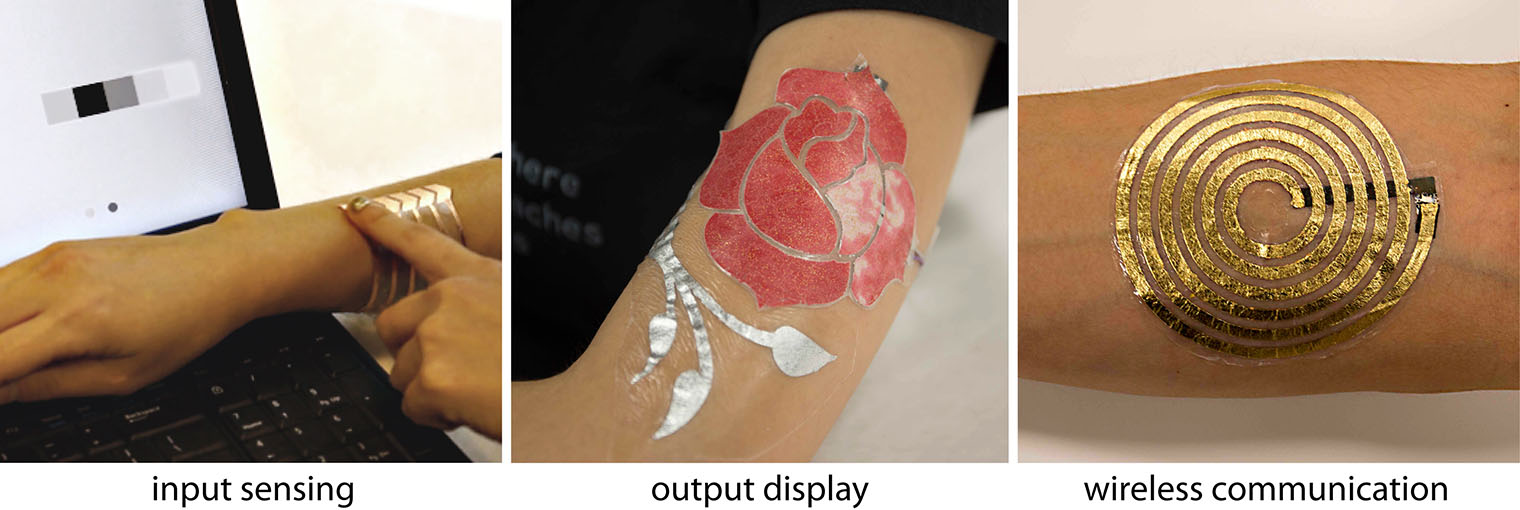DuoSkin: Rapidly Prototyping On-Skin User Interfaces Using Skin-Friendly Materials
Cindy Kao, C. Holz, A. Roseway A. Calvo, and C. Schmandt. ISWC 2016.
Microsoft Research, Redmond, WA.
Figure 1

DuoSkin is a rapid prototyping and fabrication process using the skin-friendly material gold leaf to create wearable on-skin user interfaces, such as (left) sensing touch input, (center) displaying the user's mood using a thermochromic tattoo, and (right) communicating and sharing data with other devices through NFC—all while maintaining body decoration aesthetics.
Abstract
Miniature devices have become wearable beyond the form factor of watches or rings—functional devices can now directly affix to the user’s skin, unlocking a much wider canvas for electronics. However, building such small and skin-friendly devices currently requires expensive materials and equipment that is mostly found in the medical domain. We present DuoSkin, a fabrication process that affords rapidly prototyping functional devices directly on the user’s skin using gold leaf as the key material, a commodity material that is skin-friendly, robust for everyday wear, and user-friendly in fabrication. We demonstrate how gold leaf enables three types of interaction modalities on DuoSkin devices: sensing touch input, displaying output, and communicating wirelessly with other devices. Importantly, DuoSkin incorporates aesthetic customizations found on body decoration, giving form to exposed interfaces that so far have mostly been concealed by covers. Our technical evaluation confirmed that gold leaf was more durable and preferable when affixed to skin than current commodity materials during everyday wear. This makes gold leaf a viable material for users to build functional and compelling on-skin devices. In our workshop evaluation, participants were able to customize their own on-skin music controllers that reflected personal aesthetics.
Publication

Contributions
- Our main contribution is DuoSkin, a rapid fabrication process for prototyping on-skin user interfaces.
- The key material that enables DuoSkin is gold leaf, which is skin-friendly and user friendly for fabrication. Importantly, we appropriate gold leaf as a conductor for three different modalities: sensing touch input, heating thermochromic displays, communicating wirelessly with other devices using induction (NFC).
- We demonstrate functional devices made with DuoSkin, all of which are interactive, affix to the user’s skin directly, and are robust and durable during long-term use.
- A technical evaluation on the durability and conductive properties of gold leaf and modalities of DuoSkin devices, showing DuoSkin’s viability for device prototyping.
- DuoSkin brings form to function in on-skin user interfaces, allowing users to add their sense of aesthetics to the creation of functional and decorative on-skin devices.
DuoSkin Fabrication Process

DuoSkin’s three-step workflow. Step 1: (a) Sketching skin circuitry with graphic design software. Step 2: (b) Fabrication, which includes (c) creating stencils of the circuitry, (d) applying gold leaf as the conductive material, and (e) mounting electronics. Step 3: (f) After completing the circuitry, we apply the DuoSkin device to the user’s skin through water-transfer.
DuoSkin Devices
DuoSkin allows users to create three types of user interfaces: 1) input on skin through capacitive touch sensing, 2) output on skin through thermochromic resistive heating circuitry, and 3) wireless communication through NFC.

Input sensing: Using DuoSkin, we created on-skin input elements that resemble traditional user interfaces, such as buttons, sliders, and 2D trackpads. An additional insulation layer of silicone (tattoo paper) insulates the electrode from skin. This prevents electric charges on the skin surface from interfering with the capacitive measurements. The touch electrodes are connected to a capacitive touch controller, which filters all raw data.
Output display: DuoSkin brings soft displays onto the skin, enabled through the ink-like qualities of thermochromic pigments. These displays have two different states and color change is triggered when heated beyond body temperature. Displays can also be separated into designated parts. To activate color changes on our displays, we fabricate resistive heating elements underneath the thermochromic layer. The thermochromic layer shown above comprises thermochromic pigments mixed 1:1 with a silicone base and overlaid on top of the gold leaf. The pigments change color above body temperature. We selected pigments certified for food grade packaging and toys, and encapsulated them in the silicone base for safety.
Unlike LED arrays, DuoSkin displays resemble body art, sacrificing output resolution and dynamic range for appearance. We argue that this better fulfills users’ desires, since studies have shown their preference for textile output with naturalistic aesthetics over displays directly on clothing.
Wireless communication: To exchange data across on-skin interfaces, communication needs to be wireless. DuoSkin devices communicate using NFC, whose tags comprise a chip that connects to a coil. We fabricate this coil using gold leaf, customized to various shapes and sizes.
The design of such coil antennas faces two challenges to achieve good radiation efficiency. First, the conductivity of the traces limits the radiation efficiency; a lower resistance will increase the efficiency of the tag, for example by applying additional layers of gold leaf. Second, the size of the antenna dictates the relative aperture to harvest power from the reader; a smaller coil, while blending more seamlessly onto one’s body, harvests less power, which limits range.
Conclusions
We presented DuoSkin, a rapid fabrication process for creating on-skin user interfaces. The key element of DuoSkin is gold leaf, a skin-friendly and conductive material that we appropriate for three purposes in DuoSkin devices: sensing input, powering displays for output, and near-field communication, all of which we demonstrated in a series of DuoSkin devices that we fabricated using gold leaf.
Our evaluation showed that participants preferred gold leaf for on-skin electronics compared to copper tape and thread. Gold leaf is a skin safe and aesthetic material that attracted users and at the same time exhibited robust durability, making DuoSkin devices viable for interactive purposes during everyday use over a longer period of time.
Following from our observations, we conclude that on-skin user interfaces have the potential to evolve beyond their so-far primary realm: the medical field—a domain that can afford the expensive and elaborate machinery process necessary to build epidermal electronics today. To bring more expressive forms of skin art to such on-skin devices, wearers themselves must gain aesthetic control over the fabrication process to easily implement their desired functionality.
DuoSkin work fuses the traditional practices of skin art with those found in digital fabrication to create a hybrid body decoration process, allowing users themselves to sketch, fabricate, and apply functional devices with their personally-desired purpose onto their own body. With the development in materials and automatization, we expect to see such devices and user interfaces to reach even broader adoption.
Finally, we believe that skin serves as the bridge between the physical and digital realms, enabling users to leverage the personal aesthetic principle that is often missing in today’s wearable tech. It is our vision that future on-skin electronics will no longer be black-boxed and mystified; but they will converge towards the user friendliness, extensibility, and aesthetics of body decorations, forming a DuoSkin integrated to an extent it has seemingly disappeared.